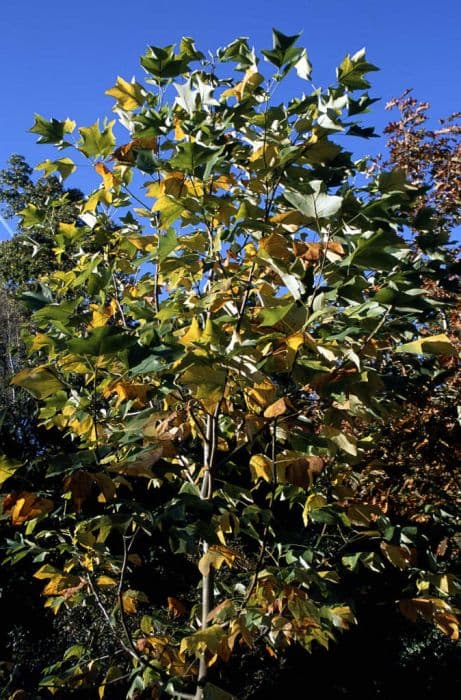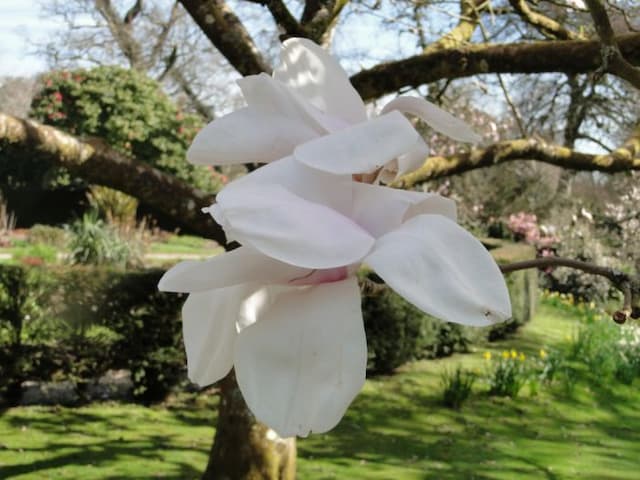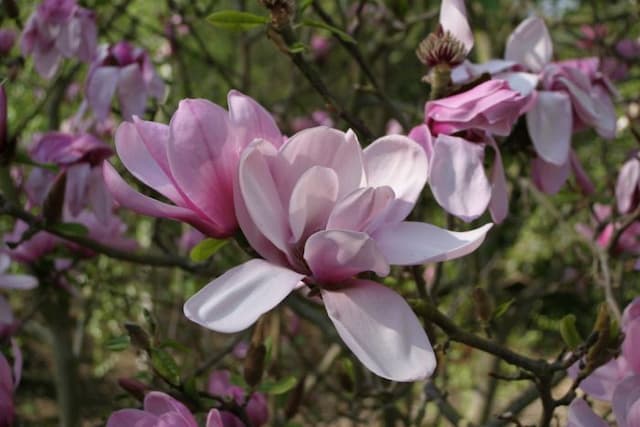Anise magnolia Magnolia salicifolia 'Wada's Memory'

ABOUT
The Magnolia salicifolia 'Wada's Memory', known colloquially as Anise Magnolia, is a captivating ornamental plant with a stunning visual appearance. This cultivar is celebrated for its impressive display of flowers that emerge in the spring. The blooms are large and creamy white, exuding an elegant aura. Each flower has a gently cupped form with petals that unfurl softly, creating an inviting display. These petals are thick and waxy to the touch, occasionally showing a faint blush of pink at their base, which adds to the allure of the blossoms. The Anise Magnolia's flowers emanate a delightful fragrance reminiscent of light citrus with subtle spicy undertones, creating an enchanting olfactory experience for passersby. The leaves of the Anise Magnolia are equally attractive. They boast a rich green color and possess a lance-like shape, reminiscent of willow leaves, hence the name 'salicifolia.' These leaves are smooth and glossy, providing a striking contrast against the soft texture of the blooms. As the seasons transition, the foliage may take on golden-yellow hues, contributing to the plant's charm during autumn. The bark of the Anise Magnolia is smooth and gray, providing a neutral backdrop that accentuates the color and form of the flowers and foliage. The combination of its aromatic flowers, pleasing leaf shape, and attractive year-round appearance makes the Anise Magnolia 'Wada's Memory' an appealing choice for garden enthusiasts who are drawn to beauty in their landscape without focusing on the overall size of the plant.
About this plant
 Names
NamesFamily
Magnoliaceae
Synonyms
Willow-Leafed Magnolia, Anise Magnolia, Wada's Memory Magnolia
Common names
Magnolia salicifolia 'Wada's Memory'
 Toxicity
ToxicityTo humans
Magnolias, including Magnolia salicifolia 'Wada's Memory', are not commonly known to be toxic to humans. There is no widespread evidence to suggest that touching or ingesting parts of this magnolia results in poisoning. However, individual allergic reactions or sensitivities are possible, as with any plant material.
To pets
Magnolias, such as Magnolia salicifolia 'Wada's Memory', are not considered toxic to pets. They are generally regarded as safe for dogs, cats, and other domestic animals. While the plant is not known to cause serious illness or fatalities, ingestion could potentially lead to mild gastrointestinal upset in some pets due to the unusual plant material, but significant toxicity is not expected.
 Characteristics
CharacteristicsLife cycle
Perennials
Foliage type
Deciduous
Color of leaves
Green
Flower color
White
Height
15-20 feet (4.6-6 m)
Spread
15 feet (4.6 m)
Plant type
Tree
Hardiness zones
5
Native area
Japan
Benefits
 General Benefits
General Benefits- Aesthetic Appeal: The Magnolia salicifolia 'Wada's Memory', commonly known as Anise Magnolia, has large, striking white flowers that add elegance and visual interest to any garden or landscape.
- Fragrance: The flowers emit a subtle, sweet fragrance, providing a sensory experience to the surroundings.
- Wildlife Attraction: It attracts pollinators such as bees and butterflies, which are beneficial for the ecosystem.
- Year-Round Interest: With evergreen leaves, it retains its foliage year-round, offering constant greenery even in the winter months.
- Shade Production: The canopy can provide a cooling shade in garden spaces during warmer months.
- Low Maintenance: Anise Magnolia generally requires minimal care once established, making it suitable for gardens where low upkeep is preferred.
- Drought Tolerance: Once established, it can tolerate periods of drought, making it suitable for regions with water scarcity.
- Privacy Screen: Its dense foliage can be used to create a natural privacy screen or windbreak in residential areas.
 Medical Properties
Medical PropertiesThis plant is not used for medical purposes.
 Air-purifying Qualities
Air-purifying QualitiesThis plant is not specifically known for air purifying qualities.
 Other Uses
Other Uses- Floral Arrangements: The fragrant, ivory-white flowers of Magnolia salicifolia 'Wada's Memory' can be used in fresh floral arrangements and bouquets to add an elegant touch to interior decor.
- Artistic Inspiration: Artists and photographers often use the striking appearance of the flowers as a subject or backdrop, capturing their beauty in various forms of art and photography.
- Natural Dyes: The bark and flowers can be experimented with to produce natural dyes for textiles, offering a range of subtle colors and hues for fabric.
- Gardening Workshops: The plant serves as an educational tool in horticulture and gardening workshops, where participants can learn about pruning techniques and care specific to Magnolias.
- Living Fences: Planting a series of Magnolia salicifolia 'Wada's Memory' can create a living fence or privacy screen that adds tranquility and beauty to landscapes.
- Sound Barrier: The dense foliage of the plant can act as a natural sound barrier, helping to reduce traffic or neighborhood noise when planted in strategic locations.
- Eco-Therapy: Due to its calming appearance and fragrance, the plant is utilized in eco-therapy and garden therapy programs to promote mental wellness and relaxation.
- Leaf Litter Mulch: Fallen leaves from the Magnolia can be collected and used as mulch, providing a natural source of nutrients as they decompose and improving soil structure.
- Creative Writing: The beauty and peaceful presence of the Magnolia provide inspiration for poetry and creative writing, often serving as a metaphor or setting in literary works.
- Bonsai Art: With proper technique, Magnolia salicifolia 'Wada's Memory' can be trained as a bonsai, offering a unique and challenging opportunity for bonsai enthusiasts.
Interesting Facts
 Feng Shui
Feng ShuiThe Magnolia is not used in Feng Shui practice.
 Zodiac Sign Compitability
Zodiac Sign CompitabilityThe Magnolia is not used in astrology practice.
 Plant Symbolism
Plant Symbolism- Perseverance and Durability: The Magnolia salicifolia 'Wada's Memory', commonly known as Anise Magnolia, is revered for its strength and ability to withstand harsh conditions, symbolizing one's steadfastness through life's challenges.
- Nobility and Dignity: Due to the tree's regal bearing and the stately appearance of its flowers, the Anise Magnolia represents an air of nobility and dignity.
- Beauty and Splendor: The exquisite blossoms of the Anise Magnolia signify magnificence and grandeur, reflecting the beauty of nature in full bloom.
- Peace and Tranquility: With its soft, pastel flowers, the Anise Magnolia is often associated with serenity and calm, offering a symbol of peace and a tranquil retreat from the outside world.
- Femininity and Purity: The delicate and pure features of the Anise Magnolia's flowers are commonly seen as symbols of femininity, chastity, and innocence.
 Water
WaterAnise Magnolia should be watered thoroughly, allowing the soil to become moist but not soggy. During the growing season, water it deeply once a week, providing about 1.5 to 2 gallons of water each time for mature trees. Adjustments should be made according to weather conditions, with more frequent watering during prolonged dry spells or high temperatures. During the winter months, reduce watering, but do not allow the soil to completely dry out. Saplings may require more frequent watering until their root systems are established.
 Light
LightAnise Magnolia prefers full sunlight to partial shade. It thrives best in a location that receives at least four to six hours of direct sunlight each day, but it can also do well in a spot with dappled sunlight. Avoid placing it in deep shade as this can affect the flowering and overall health of the plant.
 Temperature
TemperatureAnise Magnolia is hardy and can tolerate temperatures down to about 0 degrees Fahrenheit but prefers a range between 60 to 80 degrees Fahrenheit for optimal growth. During hot summer days, ensure the plant has adequate water to help mitigate heat stress. It is able to withstand brief periods of colder weather down to -10 degrees Fahrenheit, but prolonged exposure to extreme cold can damage the plant.
 Pruning
PruningAnise Magnolia benefits from pruning to maintain shape and remove any dead, damaged, or diseased branches. The best time to prune is after the tree has finished blooming, usually in late spring or early summer, to avoid cutting off next year's flower buds. Light pruning to shape the tree can be done yearly, while heavier pruning should be done less frequently only as needed for the health or aesthetics of the tree.
 Cleaning
CleaningAs needed
 Soil
SoilFor planting Wada's Memory Magnolia, use a rich, well-draining soil mix with organic matter such as compost. The optimal soil pH range for them is slightly acidic to neutral, around 5.5 to 7.0, ensuring proper nutrient absorption and plant health.
 Repotting
RepottingThe Wada's Memory Magnolia typically needs repotting every 3-5 years, or when you notice that the growth has become significantly restrained or the roots are visibly emerging from the drainage holes.
 Humidity & Misting
Humidity & MistingWada's Memory Magnolia thrives best in moderate to high humidity levels, preferably above 50%. It doesn't demand tropical humidity levels but should be protected from extremely dry air.
 Suitable locations
Suitable locationsIndoor
Place in bright, indirect light, protect from drafts, and ensure high humidity.
Outdoor
Plant in well-drained soil, partial to full sun, shelter from strong winds.
Hardiness zone
5-8 USDA
 Life cycle
Life cycleThe life cycle of Magnolia salicifolia 'Wada's Memory', also known as Anise Magnolia, begins with seed germination, typically occurring in moist, well-drained soil in a spot with partial to full sunlight exposure. As a seedling, the Anise Magnolia starts to develop its initial root system and foliage. The juvenile stage follows, with the young tree rapidly growing in height and branching out, while its leaves mature into their typical elongated, willow-like shape. Once reaching maturity after several years, the Anise Magnolia begins its reproductive phase, producing fragrant white blossoms in early spring, which are pollinated by insects. After pollination, the plant develops seed cones that release seeds in late summer or fall, thereby completing its reproductive cycle. As a perennial, Anise Magnolia can live for many decades, repeating its yearly cycle of growth, flowering, and seed production.
 Propogation
PropogationPropogation time
Spring-Early Summer
Propogation: The most popular method of propagating Magnolia salicifolia 'Wada's Memory', commonly known as Anise Magnolia, is by softwood cuttings. This typically takes place in late spring to early summer when the current season's growth is mature enough yet still soft and pliable. To propagate, a gardener would cut a 4 to 6-inch length (approximately 10 to 15 centimeters) from a healthy branch, making sure at least two sets of leaves are present. The lower leaves of the cutting are removed, and the cut end is often dipped in rooting hormone to encourage root development. The prepared cutting is then inserted into a pot filled with a mix of peat and perlite to maintain moisture and aeration. The pot is placed in a warm location with indirect light and covered with a plastic bag to retain humidity, ensuring not to let the leaves touch the plastic as this can encourage rot. Roots usually develop within a few weeks, after which the new plant can eventually be acclimatized to outdoor conditions.









![Magnolia [Felix Jury]](/_next/image?url=https%3A%2F%2Fplants-admin.emdemapps.com%2Fimages%2Fplants%2F%2Fimages%2F604b61a0b23b7.png&w=640&q=75)